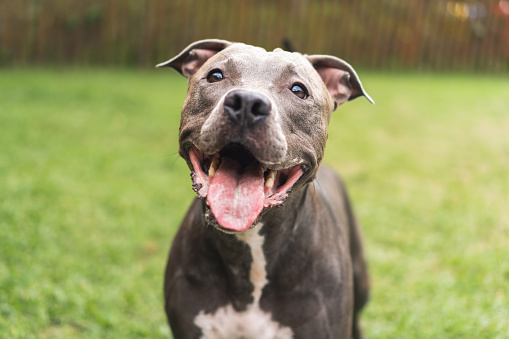The American Pit Bull Terrier is one of the most famous dog breeds due to its undeservedly bad reputation.
However, the pit bull is not only a fighting dog, but also a service dog. There was a time when it was believed that the best nanny dog for looking after small children could not be found. To better understand this breed, we suggest learning its history.
Discover the link between dog depression and lack of exercise at Soul Mutt’s Toronto. Learn how to recognize signs of a dog depressed due to insufficient walks.
Origin story
The breed was formed 300 years ago. The modern American Pit Bull Terrier has, as its name suggests, terriers and bulldogs among its ancestors.
The English Bulldog ( literally “bull dog” ) was bred to attack bulls.
The persecution of these animals was in ancient times a popular pastime. The dog had to be strong and agile enough to lunge at the bull, cling to it (most often bite on the ear or nose) and jump back before he hit or trampled it. Dogs were also used to fight with each other.
Some old pictures of bulldogs show dogs that bear a clear resemblance to pit bulls. The famous writer Walter Scott had a similar dog . He was very attached to his dog and when he died, he ordered to be buried under the windows of his office.
Over time, it was dog fights that began to gain more and more popularity, but bulldogs were too clumsy, lazy and devoid of excitement for them. Then they were crossed with terriers.
Pit Bull Terrier Breed
UKC Pit Bull Terrier Breed Standard
The head is large and broad, but not disproportionate to the body of the dog. From the front, the shape of the head resembles a wide, blunt wedge. Seen in profile, the topline of the skull and muzzle are parallel to each other and connected by a well-defined, moderately deep stop.
- The skull is large, flat or slightly rounded, deep, wide between the ears.
- The muzzle is broad and deep, tapering from the stop to the nose.
- The jaws are strong and strong.
- Scissor bite.
- Ears are natural or cropped, set high.
- The eyes are almond-shaped, set wide apart and set low on the skull.
- Any colour.
- Nose of any color with wide open nostrils.
- The neck is dry, muscular, slightly arched, widening towards the withers.
- The shoulder blades are strong, muscular, wide and obliquely set.
- The back is short and strong, slightly sloping from the withers to the base of the tail.
- The loin is short and muscular. The croup is slightly sloping.
- The chest is deep, but not too broad. True ribs are moderately convex, closely adjacent to each other, elastic, false ribs are long.
- The tail is short compared to the size of the dog, carried low and tapering towards the end. In motion and when excited, it rises to the line of the back.
- Limbs with long, rounded and strong bones without elements of roughness or load. The pasterns are straight, sheer, strong. Paws of medium size. The movements are light and springy. Waddle or amble is not allowed. The thighs are long, muscular. The hocks are low, the metatarsus is short and steep.
- The coat is shiny, short, close-lying, harsh to the touch, without undercoat; belly without hair.
- Any color except merle.
- Weight from 13 to 27 kg.
What kind of terrier added his blood is not known exactly. The resulting bull terriers had the strength of a bulldog, the agility and tenacity of a terrier, making them ideal for fighting. Based on the name of the area, the most successful variety of such dogs was called the Staffordshire Bull Terrier. Further crossing it with terriers and Dalmatians led to the appearance of the English Bull Terrier breed.
In 1835, dog fighting was banned in Great Britain. Around the same time, they began to gain popularity in America. There the breed was even called “Yanke Terrier”, but in the end the name “pit bull terrier” came into use from the word “pit” (“pit”), that is, with a hint of a dog fighting arena, which often consisted of a pit with boards on walls.
In 1898, the first club of owners and breeders of pit bull terriers, the United Kennels Club, was created, which still exists today. The club believes that there is only one breed – the American Pit Bull Terrier, which includes the American Staffordshire Terrier. Because of this, many difficulties arise for professional cynologists who do not recognize UKC pedigrees.
In 1909, some pit bull breeders left the UKC and formed the American Dog Breeders Association (ADBA). The association registered only purebred pit bulls, but extended its activities to the whole world. In addition, she worked to disseminate information and popularize the breed, and also held dog shows.
Around the same time, the American Pit Bull Terrier breed standard first emerged. But some breeders thought pit bulls were too aggressive and not pretty enough. In order to make these dogs a little more graceful and less pugnacious, selection work was carried out, and a variety of pit bull appeared – the American Staffordshire Terrier ( pictured ), in 1936 recognized as a separate breed. Proud pit bull owners often refer to Amstaffs as “decorative” or “show” pit bulls.
| Homepage | Click Hear |

